Introduction
Navigating the complexities of raising a child with autism can be challenging, particularly when it comes to managing sensory overload. Understanding overstimulation is crucial for parents and caregivers who are striving to create a supportive environment for their children. Overstimulation occurs when an individual is exposed to an overwhelming amount of sensory input, leading to anxiety, discomfort, or distress.
Children with autism are often particularly sensitive to sensory stimuli such as sounds, lights, and textures, making it essential for caregivers to recognize the signs of sensory overload and implement effective strategies to alleviate their distress. By fostering a sensory-friendly environment and tailoring coping strategies to each child's unique needs, parents can significantly enhance their child's well-being and ability to thrive. This article delves into the importance of understanding overstimulation, recognizing its signs, and creating supportive environments, while also offering practical tips for managing sensory challenges.
Understanding Overstimulation in Autism
Overstimulation occurs when a person is overwhelmed with excessive input from the senses, resulting in anxiety, discomfort, or distress. This is especially difficult for individuals on the spectrum, as they often show increased sensitivity to sounds, lights, textures, or crowded environments. Recognizing and understanding overstimulation is vital for parents and caregivers. By recognizing these perceptual sensitivities, they can better identify when their offspring is becoming overwhelmed and take appropriate measures to ease their distress. As stated by the Autism Community in Action (TACA), early intervention and prompt assistance can greatly enhance results for individuals with autism, highlighting the significance of awareness and proactive measures in addressing sensory issues. Autistic individuals often navigate a world not designed for their perceptual experiences, which can lead to immense stress and misunderstandings if not properly addressed. Assisting these children with the appropriate strategies can help them flourish despite these perceptual challenges.
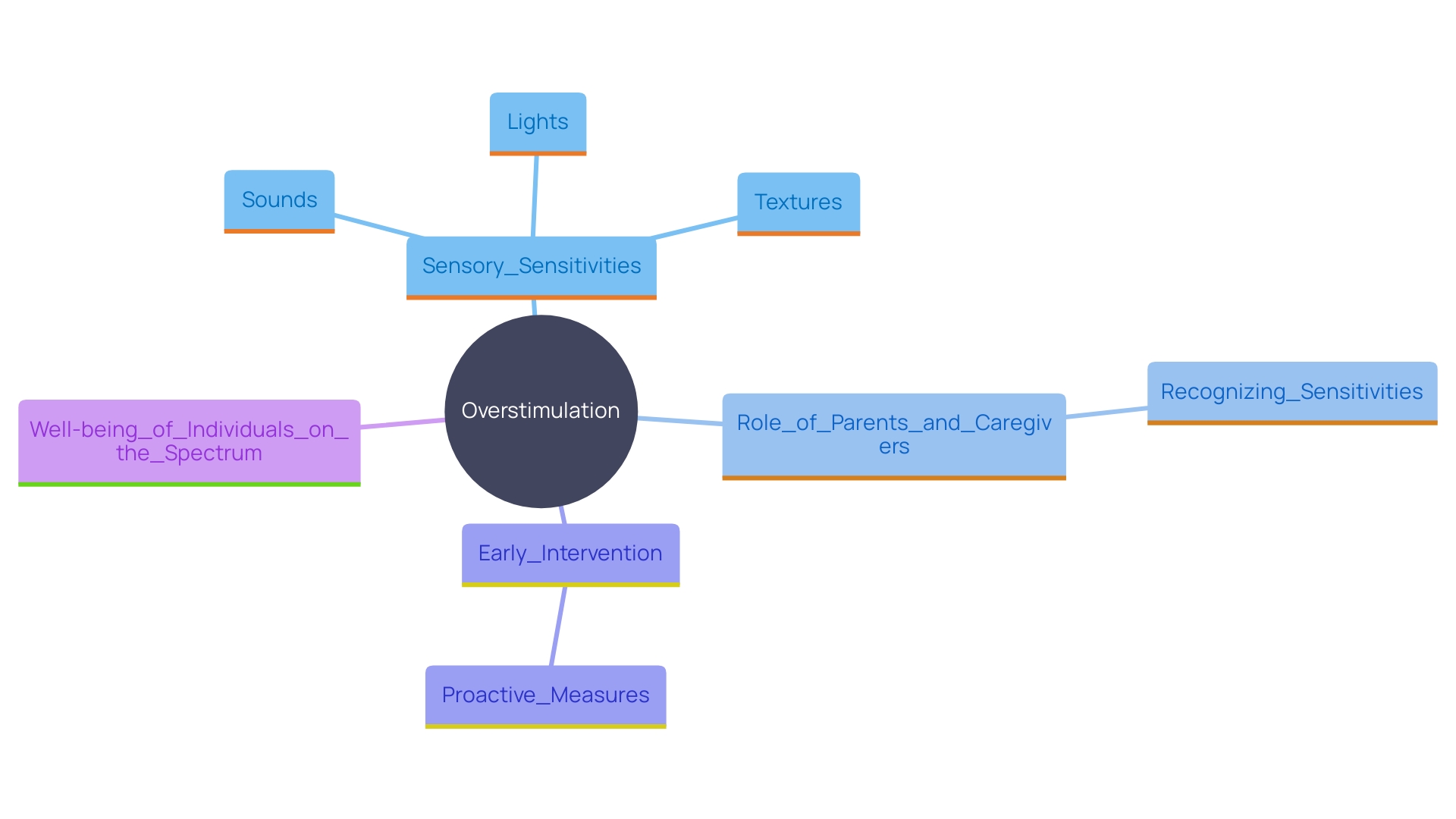
Recognizing Signs and Symptoms of Overstimulation
Recognizing signs of sensory overload is crucial for timely intervention and support. Children with this condition may display a range of symptoms when overstimulated. These can include emotional responses such as meltdowns, withdrawal, and irritability, alongside difficulties in focusing. Physically, youngsters might cover their ears, avoid eye contact, or show repetitive behaviors. It's important to remember that not all young individuals with this condition will display these behaviors, and some might exhibit none at all.
Active and tranquil involvement in daily tasks is essential for the mental well-being and growth of youngsters with disabilities, including those with autism. Offering consistent assistance and resources to caregivers guarantees they can aid their offspring in managing perceptual difficulties efficiently. As noted by psychiatrist David Offord, recognizing both the unmet needs and the strengths of these young individuals is essential for fostering their growth and inclusion in society.
Understanding these sensory processing issues from the child's perspective can guide more effective interventions. Researchers emphasize the importance of early interventions, which have been shown to improve social communication and adaptive behavior. 'While no single diagnostic tool can fully capture the complexities of this condition, the combination of caregiver insights and professional observations remains vital for accurate diagnosis and support.'.
Research has indicated that approximately 1-4% of the population is impacted by this condition, emphasizing the importance of broad awareness and comprehension. Early childhood interventions, such as naturalistic developmental behavioral interventions, have demonstrated significant benefits in areas like social communication and adaptive behavior. By remaining knowledgeable and attentive to the requirements of youngsters with developmental disorders, guardians can create a significant impact on their offspring's capacity to handle overwhelming stimuli and succeed in their everyday activities.
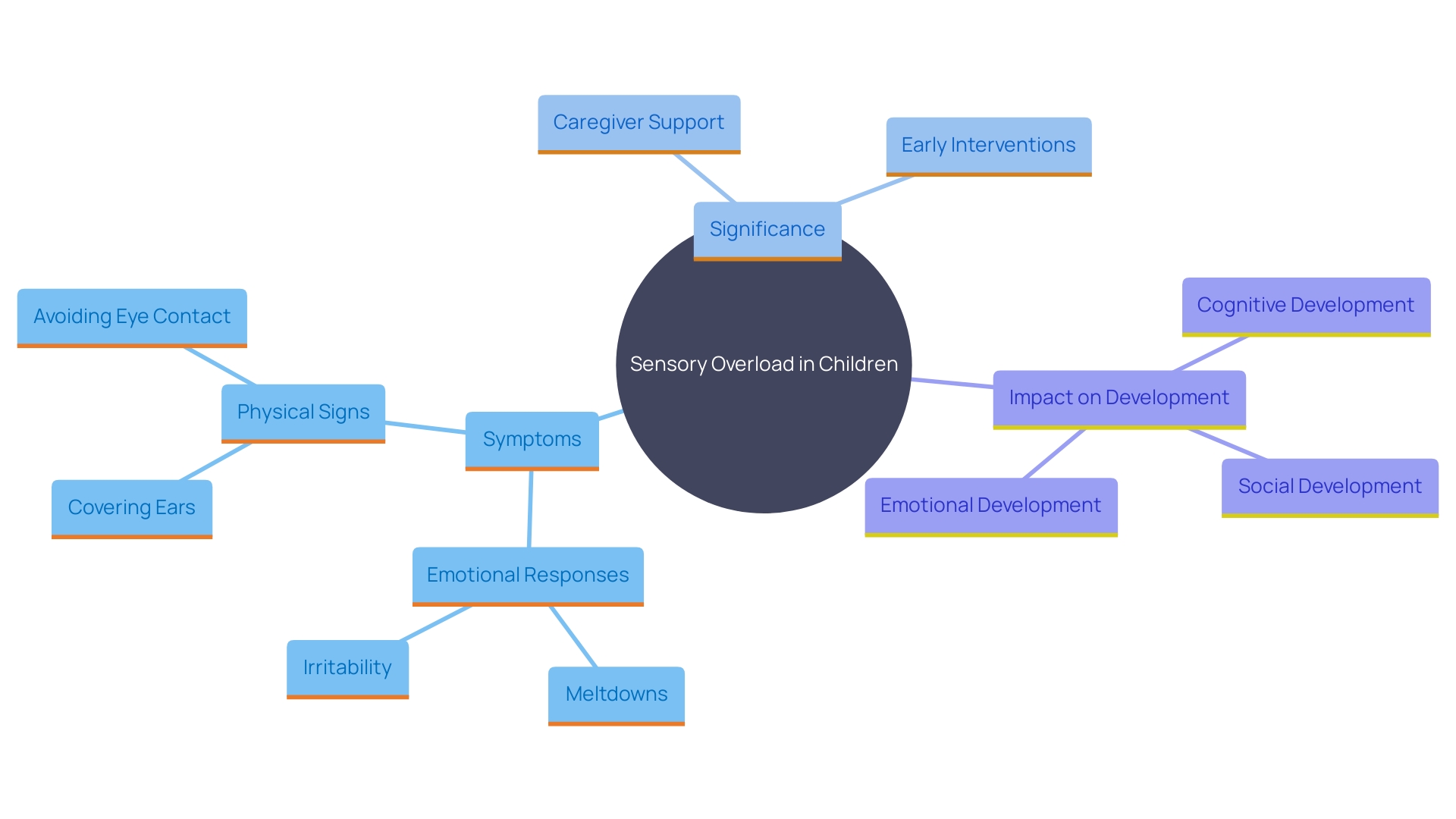
Creating a Sensory-Friendly Environment
Establishing a sensory-friendly setting can significantly decrease the chances of overstimulation for individuals with autism. This involves making thoughtful adjustments to both home and school environments to accommodate their sensory preferences. For example, minimizing loud noises and using soft lighting can create a more serene atmosphere. Moreover, offering access to soothing areas where young individuals can escape when they feel stressed is essential. Including tools that engage the senses, like noise-canceling headphones, weighted blankets, or fidget toys, can also assist in creating a more comfortable atmosphere.
Neurodivergent individuals often benefit from natural elements and adaptive spaces. Immediate encounters with nature, like observing vegetation or listening to water, can assist young individuals with developmental differences in processing information from their senses more efficiently. Research indicates that natural building elements and design features that include soft corners and retreat spaces can significantly reduce anxiety. For instance, the new outpatient facility at Jefferson Health’s Honickman Center in Philadelphia has been designed with these principles in mind, offering spaces that help visitors remain calm and relaxed. The hallways are adorned with scenes of nature, and there are designated areas for individuals who are neurodiverse to retreat and find comfort.
Studies have shown that between 69% and 95% of autistic individuals experience sensory symptoms, underscoring the importance of creating environments that address these needs. Customizing environments to be sensory-friendly can create a significant impact in the daily experiences of young individuals with sensory processing differences, assisting them in feeling more in control and comfortable in their surroundings.
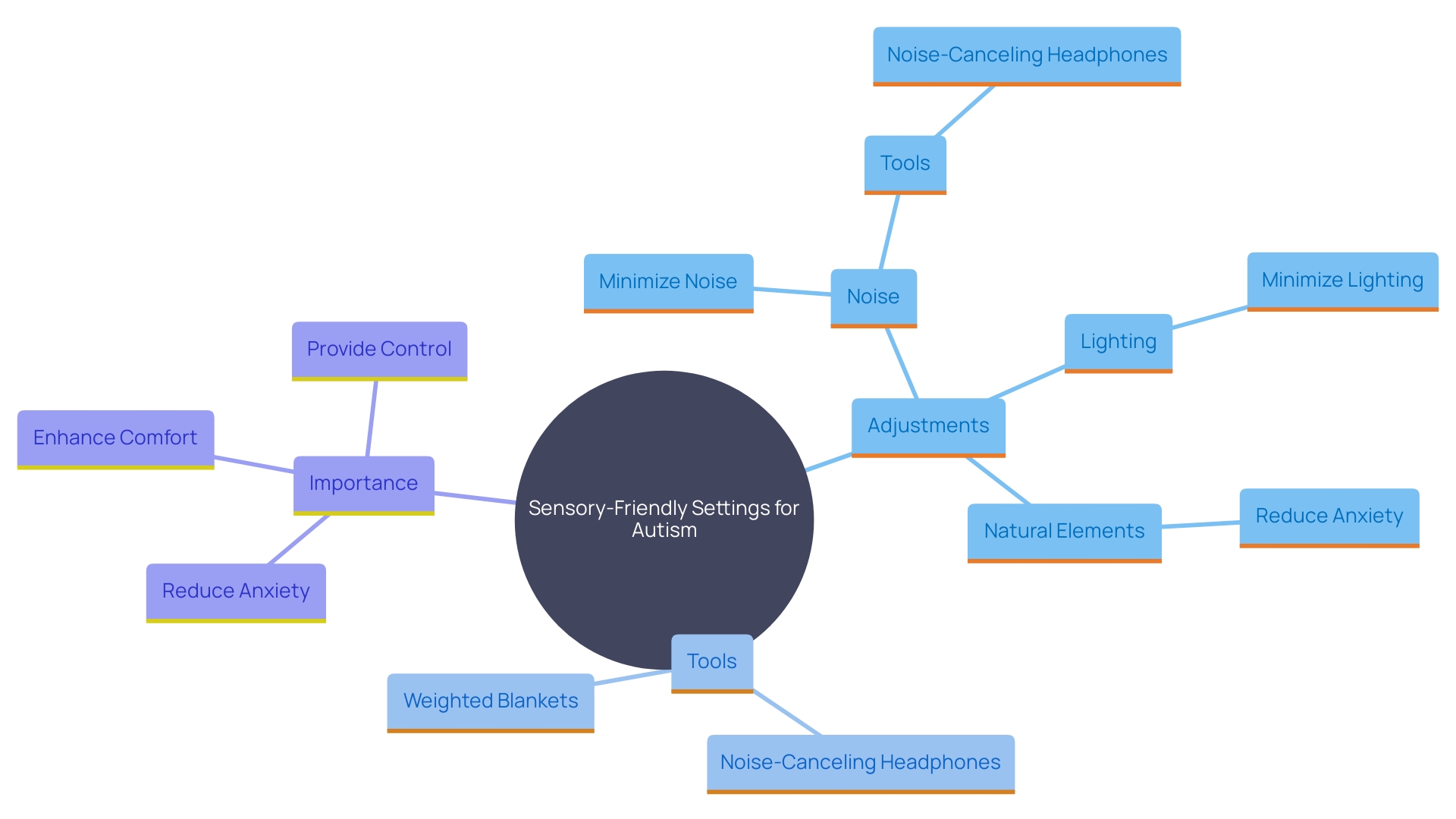
Effective Strategies for Managing Overstimulation
Establishing proactive strategies can significantly assist in handling overstimulation for kids with autism. Establishing routines provides predictability, which can be comforting and reduce anxiety. Alison Neal, Director of Midlands Occupational Therapy, emphasizes the importance of routines that align with a child's natural rhythms. Planning consistent pauses during tasks is another effective approach to avoid overwhelming stimuli. Amanda Hind, an experienced teacher and autism researcher, advocates for sensory movement breaks, which can be seamlessly incorporated into daily routines at home or school. Instructing on coping methods, like deep breathing or visualization, enables young individuals to handle their reactions to overwhelming circumstances. As emphasized by Rachel Gilgoff, MD, and Devika Bhushan, MD, young individuals often express their stress through behavior, making it essential to provide them with these tools. By anticipating and addressing sensory requirements, parents can create a more supportive atmosphere that fosters resilience and well-being in their offspring.

Importance of Personalized Coping Strategies
Every child with a developmental disorder is unique, and creating personalized coping strategies is essential. Tailoring these strategies to fit individual needs can significantly enhance their effectiveness. Collaboration with professionals, such as pediatricians and therapists, is crucial in developing these personalized plans. Early childhood interventions, especially those focusing on social communication, have shown remarkable benefits in addressing core challenges associated with autism. Involving young individuals in articulating their preferences through interviews or focus groups can yield important understanding of what is most effective for them. This not only aids in creating effective strategies but also encourages a sense of agency and control in young individuals, making them active participants in their own care.
Role of Structured Routines in Prevention
Organized routines are essential in handling sensory processing challenges for individuals with autism. By maintaining consistency, these routines assist youngsters in anticipating what will happen next, significantly reducing anxiety caused by unexpected changes. Introducing visual schedules or timers can further enhance these routines, providing clear expectations and helping young individuals feel more secure and less overwhelmed. Research indicates that individuals with autism frequently exhibit distinct attentional preferences, concentrating more on non-social stimuli such as textures or geometric shapes instead of social components like faces. This makes it even more important to establish predictable routines that cater to their specific requirements. Eye-tracking studies by the University of Geneva have highlighted these unique preferences, emphasizing the need for early interventions to guide autistic individuals towards more typical developmental trajectories. Incorporating structured routines not only helps in managing processing issues but also supports the child's overall development and daily functioning.
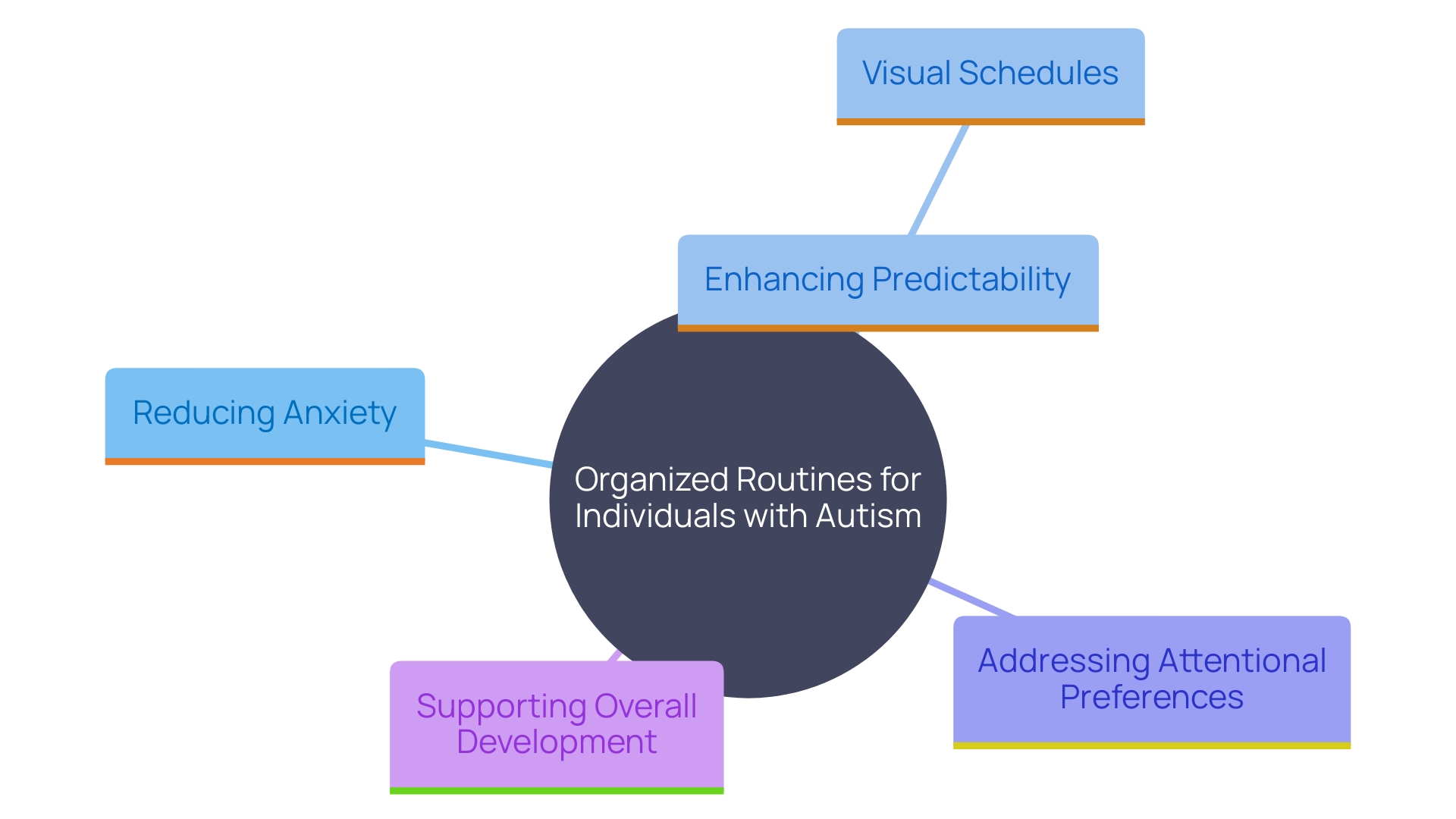
Supporting Individuals with Autism: Education and Awareness
Educating family members, peers, and educators about sensory processing issues is essential for fostering a supportive environment. By raising awareness, we can nurture empathy and understanding, enabling others to recognize and appreciate the challenges faced by individuals with autism. This understanding is crucial for promoting inclusive practices within schools and community settings, which can significantly reduce instances of overstimulation.
Research shows that early childhood interventions, especially those focusing on social communication, can lead to positive long-term outcomes for autistic children. "It's essential to establish a secure and accepting environment for families to talk about and tackle these processing challenges, recognizing that disagreements may occur due to varying requirements.". These conflicts are natural and offer opportunities for growth and the development of essential skills like problem-solving and conflict resolution.
'Real-world examples, such as the work of Alison Neal and Jignasha Button, highlight the importance of specialized occupational therapy in addressing processing issues.'. Their experience demonstrates that tailored interventions can be implemented both at home and in educational settings, providing practical solutions to everyday challenges. Moreover, the initiatives of groups such as the IACC highlight the necessity for coordinated communication and collaboration with the community affected by developmental disorders to improve the support and services offered.
By understanding and addressing perception issues, we can create more inclusive and empathetic environments that support the well-being and development of individuals with autism.
Practical Tips for Parents and Caregivers
Parents and caregivers can adopt several strategies to help youngsters manage overstimulation effectively. Frequently talking about your offspring's preferences and emotions can promote a deeper comprehension of their requirements. Creating a toolkit with soothing items such as noise-canceling headphones, weighted blankets, or fidget toys offers instant comfort for your little one during times of overwhelming stimuli.
It's also crucial to maintain open communication with educators and therapists to ensure a cohesive support system. Working together with experts guarantees that all participants are aligned and striving for the well-being of the young one. Establishing a secure, accepting environment for your child to share their experiences and preferences can significantly improve their capacity to manage challenges related to sensory input.
Furthermore, anticipating and recognizing potential conflicts arising from varied perceptual requirements within the family can transform these challenges into opportunities for development and education. Such conflicts are natural and provide a chance to develop essential skills like problem-solving, navigating boundaries, and respecting diverse requirements. By embracing these strategies, parents can create a supportive environment that addresses the unique sensory needs of their children.
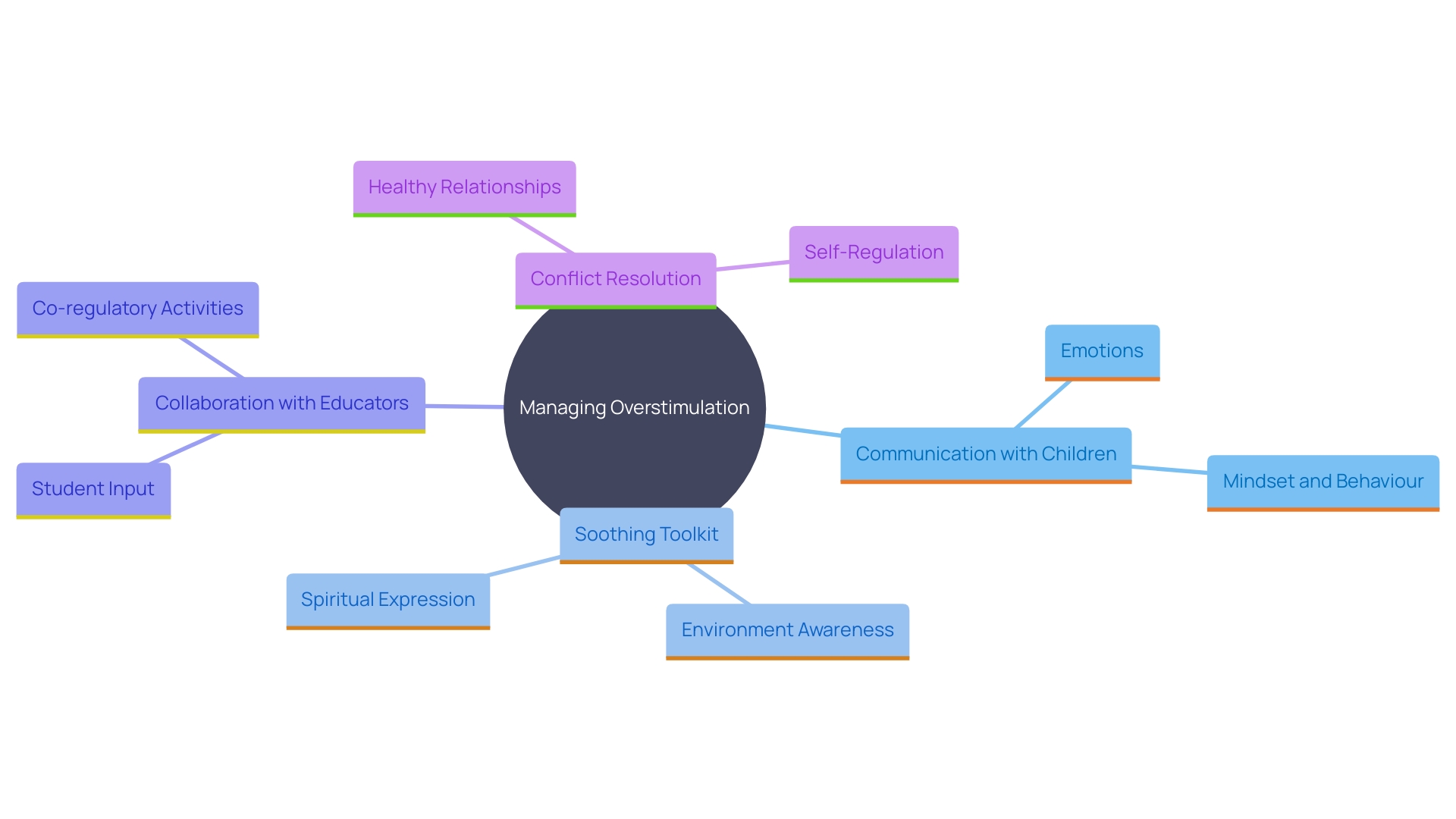
Conclusion
Understanding and managing sensory overload is essential for supporting children with autism. Recognizing signs such as meltdowns or withdrawal allows caregivers to intervene effectively and create a more nurturing environment.
Establishing a sensory-friendly atmosphere is crucial in alleviating overstimulation. Simple adjustments like soft lighting, reduced noise, and calming spaces can greatly enhance comfort. Sensory tools, including noise-canceling headphones and fidget toys, empower children to navigate their experiences more effectively.
Personalized coping strategies are vital, as each child has unique sensory needs. Collaborating with professionals to tailor approaches enhances the effectiveness of interventions. Additionally, structured routines provide predictability, helping children feel secure and less anxious about unexpected changes.
Educating family members, peers, and educators about sensory processing issues fosters a supportive environment. By promoting understanding and empathy, communities can reduce instances of overstimulation and create more inclusive settings.
Through these combined efforts, children with autism can thrive in a world that often feels overwhelming, significantly improving their quality of life and overall well-being.




